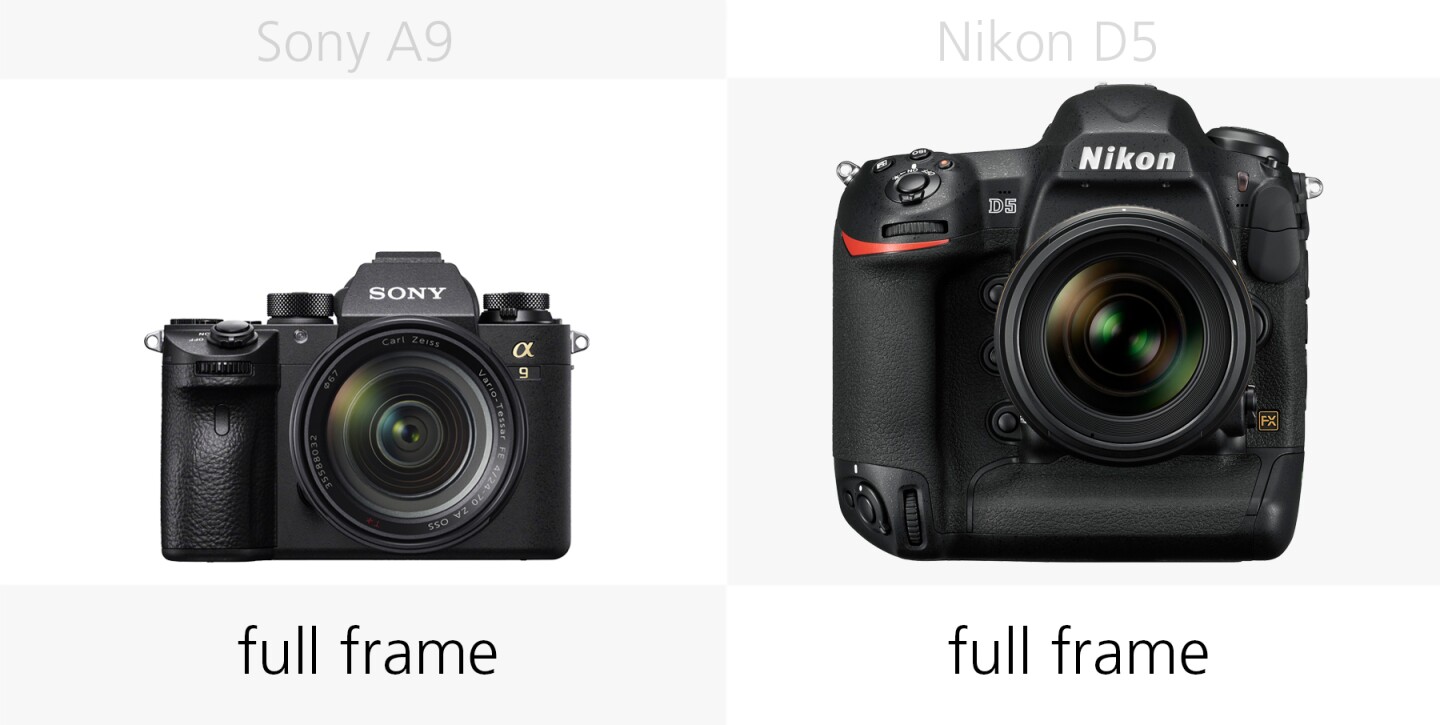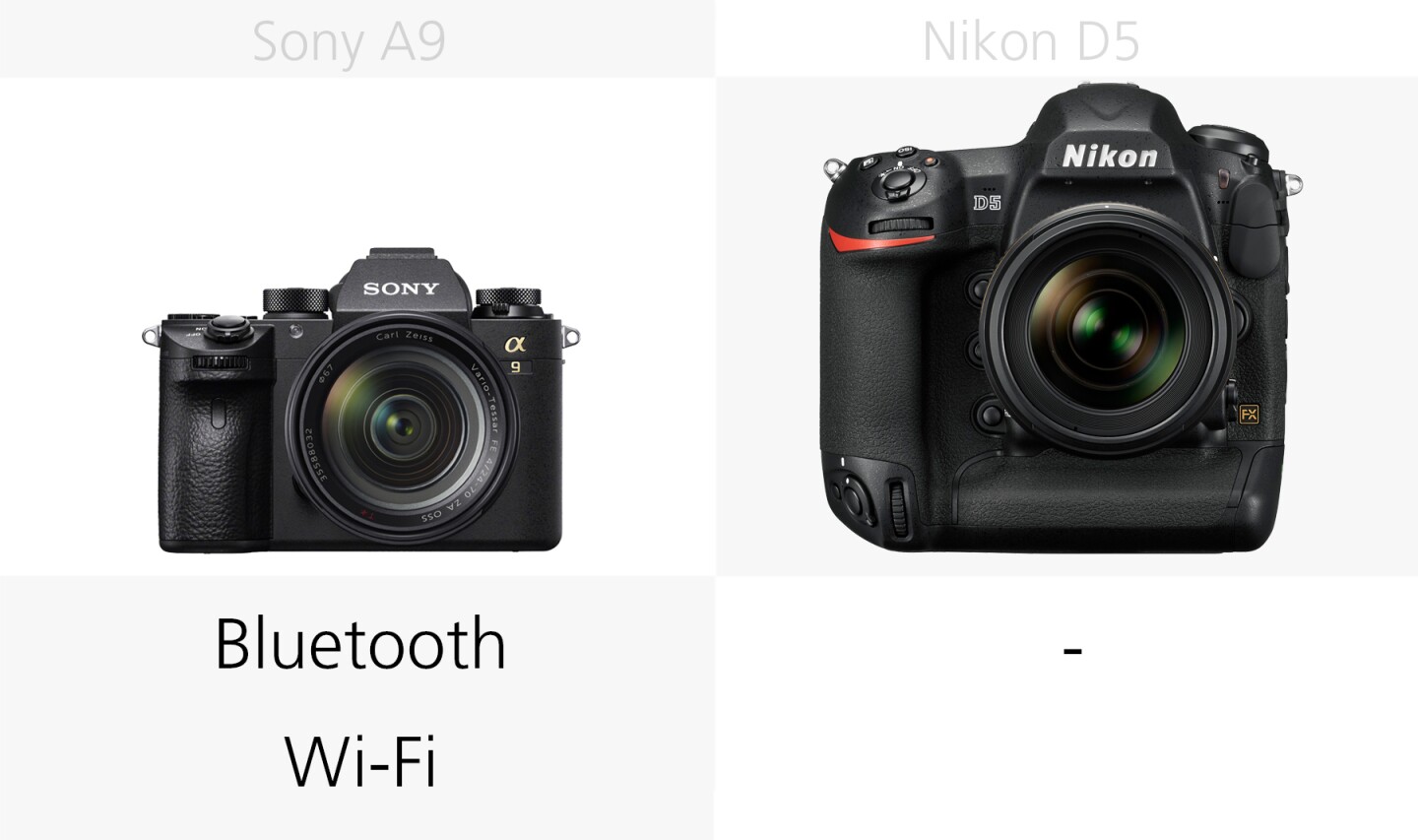The Sony Alpha A9 is a small camera with big ambitions; the full-frame mirrorless shooter is designed to take on flagship DSLRs from the likes of Nikon and Canon. But exactly how does the camera compare to those devices, which are typically used by professional news and sports photographers? Here we'll look at how the key specs and features of the Sony A9 stack up against those of Nikon's D5.
Up until now, if you wanted a fast-shooting professional camera you were probably going to get a Nikon or Canon DSLR, with flagship models like the Nikon D5 and Canon 1Dx Mark II standing head-and-shoulders above rivals. However, the Sony A9 looks like it could change that by matching (if not bettering) some of the key specs of those cameras, while also offering advantages which come from being mirrorless.
Because mirrorless cameras don't contain a flapping mirror between the lens and sensor they can be smaller than DLSRs and boast electronic viewfinders which let you see exactly how your image will turn out. Newer mirrorless cameras are also overcoming issues such as slower autofocus, which was a problem on earlier generations. For more on the differences between mirrorless and DSLR cameras you might want to check out our guide to different camera types. But for now, on with comparing the Sony A9 and Nikon D5.
Size

The new Sony A9 is truly tiny compared to the Nikon D5. Even with an optional vertical battery grip attached, it is still going to be much smaller than the professional DSLRs it's said to rival. Here we can see the way in which mirrorless cameras can be much smaller than their DSLR rivals because they don't need to house a physical mirror.
Weight

Unsurprisingly, given the size differential, the A9 is also considerably lighter than the Nikon D5. Again, even with its battery grip attached there's going to be a big difference. For reference, the weight given for the D5 is with dual XQD slots, the CF version weighs 10 g extra.
Build

Both of these cameras promise to be sturdy thanks to the use of a magnesium-alloy build. While the ruggedness and weather sealing of the D5 is a given, Sony also describes the A9 as being dust and moisture resistant.
Sensor size

There are full-frame CMOS image sensors measuring 36 × 24 mm in both the Sony A9 and the Nikon D5. This is what you would expect for cameras aimed at professional users.
Megapixel count

The Sony A9 has a slightly higher megapixel count than the Nikon D5, meaning it will resolve more detail. While neither camera offers the sky-high resolutions of devices like the Canon 5Ds or Sony A7R II, this is typical of flagship cameras which prioritize speed.
Processor

The image processors in this duo are the best their respective manufacturers have produced. That means each camera is able to deliver high-quality images and video quickly, and generally keep things running smoothly.
Lens mount

The Nikon D5 uses the F-mount which has been used on the firm's DSLRs for generations, while the A9 employs the E-mount we've seen on most of Sony's mirrorless cameras.
There are far more lenses available for the Nikon F-mount, particularly those that meet the demands of professional snappers, such as fast telephoto options. However, other lenses including Sony A-mount lenses, along with some from rival manufacturers, can be used on the A9 with adapters.
Stabilization

Unlike most flagship DSLRs, the Sony A9 boasts built-in image stabilization, meaning you don't have to rely on stabilized lenses to reduce wobble-induced blur. It's claimed this 5-axis sensor-shift system offers shake compensation equivalent to using a 5.0-stop faster shutter speed.
Autofocus

Speedy autofocus is pretty much guaranteed with either of these cameras. The autofocus on the Nikon is one of the fastest and most accurate we've ever used thanks to its 153-point system. That said, the Fast Hybrid AF on the Sony also promises to be something special with its 693 points covering 93 percent of the frame, and features like enhanced eye detection.
Burst rate

A blisteringly fast top continuous shooting speed of 20 fps will no doubt help the Sony A9 appeal to photographers who have previously used flagship DSLRs and become accustomed to their machine-gun-like firing. That said, the 12 fps of the Nikon D5 (or its 14 fps with the mirror locked up) will still be more than enough for most users.
ISO range

If you are going to be shooting at high ISO settings the Nikon D5 still looks like the way to go. Its top native ISO of 102,400 (expandable to ISO 3,280,000) allows shooting in almost all light conditions. However the ISO range of the A9 is nothing to sneeze at, and itself allows shooting in darker situations than would have been possible with previous generations of the camera.
4K video

4K video shooters will be pleased with the ability to record at up to 30 fps on both cameras. It's worth noting that while the D5 was limited to shooting for just three minutes when it was launched, a firmware update has since extended this to the more standard 30 minutes.
Full HD video

Lowering the resolution to Full HD 1080p increases the top frame rate of both cameras. The 120 fps of the Sony allows users to produce smooth slow-motion footage in Full HD.
Viewfinder

A big difference between these two is the type of viewfinder they use, because one is a mirrorless camera, and the other is a DSLR. The Sony has the sort of electronic viewfinder (EVF) typically found on mirrorless cameras, which lets you see what impact changing settings will have on your images. Meanwhile, the Nikon D5 adopts a traditional optical viewfinder, like those seen on previous generations of DSLRs and SLRs, and shows you a reflected view through the lens.
Also notable is that an EVF isn't the disadvantage it would have been a couple of years ago, when they were small and laggy. This OLED version boasts 3,686,400 dots and a standard refresh rate of 60 fps (which can be increased to 120 fps), along with a promise of blackout-free shooting.
Monitor

Touchscreen rear monitors are finally becoming a standard feature on high-end cameras, and as such, are present on both of these devices. While the monitor on the D5 has the benefit of a higher resolution, the one on the Sony can be tilted for shooting at otherwise awkward angles.
Photo file type

Both cameras can shoot either RAW or JPEG images, though the Nikon has the advantage of shooting different size RAW files depending on your needs.
Storage media

Dual memory cards slots on these cameras mean users have the option to shoot different filetypes to different cards, perform constant backups, or simply increase capacity. The A9 features two SD slots (one of which can also accept Sony Memory Stick cards). Meanwhile, the D5 is available in two configurations, with either dual XQD or dual CF slots.
Wireless

If you want to transfer images from a Nikon D5, you'll need to either take the card out, or invest in a optional wireless transmitter. The Sony A9 on the other hand, comes with the Wi-Fi and Bluetooth connectivity users might expect for this level of camera in 2017, allowing wireless sharing and remote shooting.
Battery life

When it comes to battery life there is one very clear winner. The Nikon D5 can keep shooting for more than five times as long as the Sony A9. Even with two batteries in the optional A9 vertical grip, the A9 won't keep you shooting as long.
Release

The recently-announced Sony A9 is due for release just over a year after the Nikon D5 hit the shelves of camera stores. New generations of flagship DSLRs are typically only released every four years (though there's often a mid-cycle incremental upgrade after two years), so we'd expect the D5 to remain as Nikon's closest rival to the A9 for at least the next year.
Price

The Nikon D5 is going to set you back an extra US$2,000 (body-only) compared to the Sony A9. However, depending on what lenses you are going to need, or already have, this saving could soon disappear.
Wrap-up
There's no doubt the Sony A9 is one of the most interesting cameras to be released in the last few years. While countless mirrorless cameras have been billed as "DSLR-killers," few have dared to take aim at high-end flagship DSLRs. The Sony A9 does, and looks like it might live up to the promise.
The traditional drawbacks of mirrorless cameras are beginning to matter much less than they did just a couple of years ago. Looking at the specs of the A9 we can see there's no longer any need to worry about the usability of its EVF, or the speed of its autofocus. Battery life and lens options might still be a concern, but savings in size and weight could balance that.
With the Nikon D5, users pretty-much know what they are getting, and the chances are they're already invested in the Nikon system, or at least have experience using it. Meanwhile, the Sony A9 is still something of an unknown for many professional photographers, and while we've compared specs here, its use in the real world will truly show what the camera can do. We can't wait to get our hands on one to try it out and let you know what we think in a review.

























![The Ti EDC [everyday carry] Wrench is currently on Kickstarter](https://assets.newatlas.com/dims4/default/0ba225b/2147483647/strip/true/crop/4240x2827+0+3/resize/720x480!/quality/90/?url=http%3A%2F%2Fnewatlas-brightspot.s3.amazonaws.com%2F59%2Fb2%2F6a6fdd0348a8bfdad88bbcefec53%2Fdsc03572.jpeg)